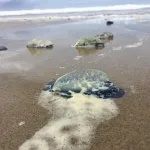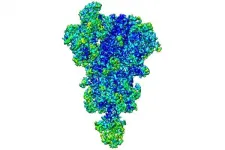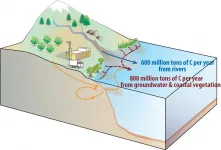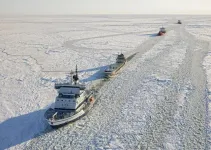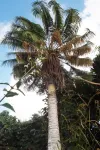(Press-News.org) As their name suggests, by-the-wind sailor jellyfish know how to catch a breeze. Using a stiff, translucent sail propped an inch above the surface of the ocean, these teacup-sized organisms skim along the water dangling a fringe of delicate purple tentacles just below the surface to capture zooplankton and larval fish as they travel.
At the mercy of the wind, these jellies can wash ashore and strand -- sometimes numbering in the trillions -- on beaches around the world, including up and down the U.S. West Coast. And while these mass stranding events are hard to miss, very little actually is known about how or why they happen.
Now, thanks to 20 years of observations from thousands of citizen scientists, University of Washington researchers have discovered distinct patterns in the mass strandings of by-the-wind sailors, also called Velella velella. Specifically, large strandings happened simultaneously from the northwest tip of Washington south to the Mendocino coast in California, and in years when winters were warmer than usual. The results were published March 18 in the journal Marine Ecology Progress Series.
"Citizen scientists have collected the largest and longest dataset on mass strandings of this jelly in the world," said senior author Julia Parrish, a professor in the UW School of Aquatic and Fishery Sciences and executive director of the Coastal Observation and Seabird Survey Team, known as COASST.
"This paper contributes to fundamental scientific knowledge of this organism in a way that traditional 'mainstream' marine science has been unable to do. Thousands of trained, dedicated observers are better than any satellite because they know their beach and can alert us if something is weird or unusual."
COASST's citizen scientists are trained to search for and identify carcasses of marine birds that have washed ashore at sites from northern California to the Arctic Circle. Participants are asked to record and submit photos of anything strange or different they see on their stretch of beach.
In 2019, program managers received an email from COASSTers in Oregon who had expected to see Velella on their beach based on past observations, but hadn't. That prompted COASST scientists to comb the database -- 23,265 surveys in total -- to see if others had taken note of these jellies over the years. This "data-mining" returned 465 reports of Velella littering 293 beaches, often in more than one year.
"On the water, Velella are beautiful, fragile creatures. When they wash ashore, these jellies quickly dry to the consistency of potato chips. During a mass stranding it's like walking on a crunchy carpet," Parrish said. "So of course, COASSTers reported in. Suddenly, we realized we had the largest dataset about Velella velella anywhere in the world."
In analyzing the citizen science observations, UW researchers discovered that most by-the-wind sailors wash ashore on West Coast beaches during the spring, when the winds shift and push the organisms to shore. However, their analysis also revealed truly massive stranding events in 2003-2005 and again in 2015-2019. During the later years, jelly carcasses covered more than 620 miles (1,000 kilometers) of continuous coastline, all within a single two-week window between mid-March to mid-April.
The second period corresponds with the timing of the long-lasting marine heat wave known as "the blob" -- also to blame for the largest seabird die-off of common murres, as well as mass die-offs of Cassin's auklets, sea lions and baleen whales.
The researchers hypothesized that warmer winters during these years allowed for populations of by-the-wind sailors to spike in the open ocean. Then, when the winds shifted in the spring, massive numbers of the jellies were swept to shore and stranded.
Put another way -- and though many ultimately end up dying on beaches -- the jellies appear to be "winners" during warmer periods, because they can amass more numbers in the ocean. There's some evidence that warmer-than-average winters are also calmer and less wavy in the open ocean, allowing increasingly large Velella aggregations to persist, Parrish explained.
"This paper and our data really do suggest that in a warming world, we're going to have more of these organisms -- that is, the ecosystem itself is tipping in the direction of these jellies because they win in warmer conditions," Parrish said. "A changing climate creates new winners and losers in every ecosystem. What's scary is that we're actually documenting that change."
As warmer winters are expected to increase with climate change, these findings could have clear implications for this jelly population, as well as for the fish they eat and the beaches where they strand and die.
INFORMATION:
The paper's lead author is Timothy Jones, a UW postdoctoral researcher in aquatic and fishery sciences. Hillary Burgess, now with the NOAA Office of Marine Debris, is a co-author.
This research was funded by Washington Sea Grant and National Science Foundation.
For more information, contact Parrish at jparrish@uw.edu.
Michelle Ma
University of Washington
mcma@uw.edu END
When it comes to the use of driverless vehicles, an individual's support for their adoption hinges on how safe they are, rather than their economic impact or privacy concerns stemming from the data they might collect, a Nanyang Technological University, Singapore (NTU Singapore) study of 1,006 Singaporeans has found.
The NTU Singapore study led by the Wee Kim Wee School of Communication and Information exposed its participants to positive and negative blog posts about driverless vehicles and their safety, their impact on jobs and the economy, ...
The collaborative work is published online in the journal Communications Biology on March 8th, 2021.
The power of photosynthesis
Photosynthesis represents the only biological process, which converts the energy of sunlight into chemically stored energy. On molecular level, the photosynthetic key enzymes called photosystems are responsible for this conversion process. Photosystem I (PSI), one of the two photosystems, is a large membrane protein complex that can be present in different forms - as monomers, dimers, trimers or even tetramers.
New isolation technique helps revealing ...
An international team of scholars studied how the COVID-19 pandemic has impacted Europeans' stress levels and their trust in their national governments and the healthcare systems. They found that respondents were most stressed by the state of the national economy, and only after that, by the risk of catching COVID-19 and possibly being hospitalized. The results of the study were published in Royal Society Open Science.
The authors of the study represent over 50 universities. Among them is Dmitrii Dubrov, Junior Research Fellow at the HSE Center for Sociocultural Research, who developed and organized the global survey, COVIDiSTRESS. The researchers studied the psychological ...
An international study led by the University Complutense of Madrid (UCM) proposed new computational image processing methods that improve the analysis and three-dimensional reconstruction of biological macromolecules.
Currently, determining the composition (i.e., the sequence of amino acids) of macromolecules such as proteins is relatively simple; however, determining the shape in which they are ordered in a three-dimensional structure is not. The new methodology, published in Nature Communications, improves the visualization of the 3D reconstructions obtained through cryogenic electron microscopy, as well as their quality.
"This study helps us broaden our understanding of proteins ...
Every year 600-900 million tons of carbon flow through rivers to the ocean either as particles or in dissolved form. Researchers have known for a long time that this does not represent the total amount of carbon that gets transported from the land to the ocean. But the remaining contributors mostly from coastal ecosystems, such as carbon-rich mangrove forests, and from groundwater discharge into the ocean have been notoriously difficult to measure.
A new study published in the journal Global Biogeochemical Cycles and spearheaded by Dr. Eun Young Kwon, project leader at the IBS Center for Climate Physics South Korea provides new estimates of this elusive component of the global carbon cycle. The study makes use of the existence of two stable carbon isotopes, 12C and 13C, with the latter ...
Statisticians have calculated the probability of ships of different Polar Ship Categories becoming beset in ice along the Northern Sea Route. Their data will help assess the risks of maritime traffic in the Arctic.
The results of the new study, published recently in the Cold Regions Science and Technology journal, will support safer maritime transport planning and the prevention of oil spills. The results will also benefit authorities that regulate maritime traffic by providing a foundation for statutes and legislation. A comprehensive approach to computing helps shipping companies plan transport routes.
Tankers more common on the Northern Sea Route
The Northern Sea Route is attracting more tankers and cargo ships travelling from Russia and ...
Powerful and squat stegosaurs are now one of the most recognisable dinosaurs: they are easily identified by the spines on the tail and the bony plates on the back - osteoderms. The representatives of this group lived about 165-125 million years ago, during the Jurassic and early Cretaceous periods. They were five to seven metres long and had a disproportionately small head. Their teeth were therefore quite small - about a centimetre in height and about the same in width.
Palaeontologists from St Petersburg University worked together with colleagues from: the Zoological Institute of the Russian Academy of Sciences; the ...
The ocean covers about 70% of the Earth's surface area and is the largest reservoir of energy. Researchers have been exploring the approach for harnessing ocean energy to solve the world energy crisis and pollution problems caused by thermal power generation. The nanogenerator, including piezoelectric, triboelectric, and pyroelectric nanogenerators, is one of the key technologies for mechanical energy conversion. The triboelectric nanogenerator (TENG) makes use of the triboelectric effect and electrostatic induction to harvest mechanical energy based on contact or sliding electrification.
However, conventional TENG device is often based on solid/solid contact, and it is hard to ensure the contact intimacy of the two tribo-materials. In the meanwhile, the material surfaces will wear or become ...
Research from the University of Kent's School of Biosciences has revealed that a molecule produced by the human immune system can severely diminish the potency of certain antibiotics.
This may explain why antibiotics effective in laboratory settings can be less effective at clearing infections in humans.
The research findings, which have been published in the journal Archives of Microbiology, reveal that nitric oxide, a molecule produced by our immune systems, can render aminoglycoside antibiotics ineffective when used against E. coli strains isolated from ...
Geopolitical boundaries can have a profound effect on the protection of threatened species. A case in point is the native cycads of the United States. A recent review paper written by researchers at the Western Pacific Tropical Research Center at the University of Guam highlights extinction risks of cycad species that occur in U.S. controlled lands and the profound effect geopolitical boundaries has had on the protection of these threatened species. The paper appears in the December 2020 issue of the MDPI journal Diversity.
Cycads are the most threatened plant order worldwide. This is due to a combination of factors including habitat loss, poaching predation by invasive species, and lack of appropriate ...
